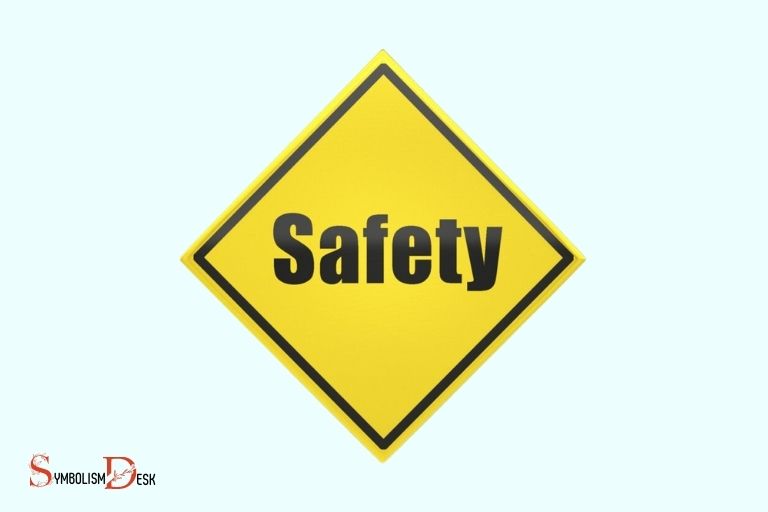What Does This Safety Symbol Mean? Hazards!
A safety symbol is a sign or emblematic representation that is used to provide information about safety and health-related concerns or hazards.
Safety symbols are often used in workplaces, public spaces, and products to warn people about potential risks.
They can indicate the presence of hazardous materials, the need for personal protective equipment, precautions to take or actions to avoid.
These symbols are universally recognized, ensuring clear and consistent communication across languages and cultures.
Safety symbols are an essential tool for communicating safety and health-related information.
They are designed to be easy to understand and universally recognized, ensuring that people, regardless of their language or culture, can be aware of potential hazards and take appropriate precautions.
10 Safety Symbols and Their Meanings
| Safety Symbol | Meaning |
|---|---|
| Biohazard | Represents biological substances that pose a threat to the health of living organisms. |
| Radioactive | Indicates radioactive sources, materials, or devices. |
| Toxic | Identifies substances that are hazardous to health if swallowed, inhaled, or contacted by skin. |
| Explosive | Alerts to the presence of substances or chemicals that can cause explosions. |
| Corrosive | Indicates substances that can destroy or irreversibly damage substances they come into contact with. |
| Flammable | Warns of the presence of substances that can easily catch fire in the presence of a flame or heat. |
| Oxidizing | Denotes substances that can burn or facilitate combustion in the presence of oxygen. |
| Electrical Hazard | Alerts to possible danger from electrical equipment or live wires. |
| Slippery Surface | Warns of areas where slips and falls can occur. |
| Falling Objects | Indicates possible risk of injury from falling objects. |
Key Takeaway

Five Facts About: Meanings of Safety Symbols
The Importance Of Safety Symbols
The Significance Of Safety Symbols To Avoid Accidents
The significance of safety symbols cannot be emphasized enough.
Safety symbols are universally recognized graphic symbols that convey vital information on potential hazards, and how to avoid them.
Without safety symbols, workers and the public in general would have no quick reference to handle hazardous situations.
Their use substantially reduces the number of accidents that occur in the workplace and public areas.
Here are some key points to note:
- Safety symbols are usually used in workplaces and public areas to convey important safety information.
- These symbols can convey information related to warning, prohibition, and mandatory actions.
- Safety symbols are effective in conveying safety information across different language barriers.
How Safety Symbols Promote Safety In Workplaces And Public Areas
Safety symbols are powerful communication tools for promoting safety in workplaces and public areas.
Using clearly visible safety symbols that are easy to understand can significantly reduce the risk of accidents and injuries.
Here are some key points to note:
- Safety symbols can promote safety through visual representation, drawing attention to safety information.
- Use of safety symbols can effectively prevent confusion and misinterpretation of safety signs.
- Safety symbols can be a reminder to employees and individuals to adhere to safety practices.
The Legal Requirements For Using Safety Symbols In Different Industries
Different industries have their own set of standards for the use of safety symbols and signage. Understanding legal requirements is crucial to ensuring compliance and safety in the workplace.
Here are some key points to note:
- Different industries have their own legal requirements of using specific safety symbols.
- Compliance with legal requirements ensures consistency and standardization of safety symbols used across the industry.
- Failure to adhere to legal requirements can result in hefty fines and penalties.
Safety symbols are vital for promoting safety in workplaces and public areas. They provide a universal means of communicating safety information effectively, regardless of the language spoken.
Using safety symbols, adhering to legal requirements, and promoting safety practices can reduce accidents and prevent injuries.
Understanding Common Safety Symbols
Safety symbols are ubiquitous and have become an essential part of our daily lives.
From the workplace to the community, different safety symbols play a vital role in conveying important safety instructions to prevent accidents and hazards.
Here are some commonly used safety symbols and their meanings:
The hazardous material symbol: This symbol is a warning of potential danger from hazardous materials.
The image usually depicts an exploding flask with an exclamation mark or skull and crossbones. This symbol indicates that the material is lethal, toxic, or radioactive.
The prohibition sign: The prohibition sign is used to prohibit certain behaviors, such as no smoking, no entry, or no photography. This symbol typically displays a circle with a diagonal line through it.
The Importance Of Recognizing Safety Symbols From Different Countries And Industries
In today’s interconnected world, it’s not uncommon to encounter safety symbols from different countries or industries.
Therefore, it’s essential to understand the significance of safety symbols because recognizing them can be a matter of life or death.
Here are some reasons why it’s important:
Different countries follow different safety standards: Safety symbols are not only different from country to country but also industry to industry; hence, recognizing safety symbols is crucial for the safety of both locals and foreigners.
Avoid accidents and hazards: Understanding safety symbols relevant to your work or surroundings can help you avoid accidents and hazards.
For example, recognizing the “eye protection required” sign can help you prevent injuries caused by foreign objects entering your eyes.
The Evolution Of Safety Symbols And How They Have Changed Over Time
Safety symbols have evolved throughout history, and its primary goal has been to keep people safe.
Here are some key points about how safety symbols have evolved over time:
Historical safety symbols: The earliest known safety symbols date back to ancient times, where workers would use symbols to indicate safe zones, dangerous areas, and toxins.
Standardization of safety symbols: Standardized safety symbols were first introduced in the 1920s, when the american standards association developed a list of safety symbols to promote uniformity.
Safety symbols in the digital age: Since the advent of the internet, safety symbols have become more accessible and more widely used across different industries and cultures.
They have also become more interactive and digital, and their meanings have become clearer and easier to understand.
Recognizing safety symbols is essential for our safety in different environments.
Understanding the meaning of these symbols from different countries and industries and how they have evolved over time can help us work more safely and effectively.
Dealing With Specific Safety Symbols
What does this safety symbol mean: dealing with specific safety symbols
Safety symbols are essential for conveying information about hazards and safety measures in various industries.
These symbols enable people to quickly understand the potential danger and the necessary precautions they should take. These symbols enable people to quickly understand the potential danger and the necessary precautions they should take. For instance, the 3 dot symbol meaning can vary depending on the context, but it often conveys a sense of incompleteness or continuation, urging individuals to seek further details. By recognizing such icons, individuals can respond appropriately and mitigate risks effectively in both everyday and specialized scenarios.
We will look at the different types of symbols, their meanings, and legal requirements in specific industries.
What Does This Safety Symbol Mean: Fire Safety Symbols
Fire safety symbols are critical for workplaces, schools, and homes.
Below are the types of fire safety symbols and what they represent:
- Fire exit signs: Show the quickest escape route in case of fire.
- Fire alarm symbols: Indicate the location of fire alarms that one should activate in case of an emergency.
- Fire extinguisher signs: Show the location of fire extinguishers and the classes of fire they are appropriate for.
There is a legal requirement for the use of fire safety symbols in specific industries. In workplaces, schools, and public buildings, fire safety symbols must be placed in clearly visible locations.
In the united states, the occupational safety and health administration (osha) governs the use of safety symbols in the workplace.
The Different Types Of Fire Safety Symbols And What They Represent
Fire safety symbols have specific shapes and colors to convey their meanings.
The shapes of fire safety symbols are often geometric in design and, when displayed in color, provide more information.
Here are a few examples:
- Red for fire exit signs.
- Blue for fire alarm symbols.
- Green for fire extinguisher signs.
For example, a fire extinguisher sign with a red rectangle and white letters indicates a water extinguisher, while a black square with a white letter b indicates carbon dioxide as the agent.
Understanding these different symbols and shapes can help ensure safety in case of a fire emergency.
The Legal Requirements For Fire Safety Symbols In Particular Industries
Different industries have varying legal requirements for fire safety symbols.
For example, in the united states, the national fire protection association (nfpa) provides the codes and standards for fire safety symbols in various industries.
In schools, it is required that there are fire drills involving all students and staff members.
A designated assembly area is required for all occupants of a building so that they can gather safely away from the building after an evacuation.
What Does This Safety Symbol Mean: Electrical Safety Symbols
Electrical safety symbols are critical for anyone working with electricity.
Below are some essential electrical safety symbols and their meanings:
- Power on/off symbol: Indicates whether a power supply is on or off.
- Earth/ground symbol: Indicates the existence of a ground connection.
- Shock hazard symbol: Indicates that contact with live parts could cause electric shock.
These symbols help prevent electrical accidents that could cause serious injury or even death.
The Importance Of Electrical Safety Symbols In Preventing Electrical Accidents
Electrical safety symbols are necessary because electricity is invisible and can cause dangerous situations.
Ignoring electrical safety symbols could cause electrical shocks, burns, and explosions, among others.
These symbols can be found on electrical equipment, switches, control panels, and more.
Electricians and other trained professionals must understand these symbols to ensure that they can work safely with electricity.
An Explanation Of Common Electrical Safety Symbols And How To Interpret Them
Identifying electrical safety symbols and their meanings can be lifesaving.
Here are some standard symbols:
- Circle with a vertical line: This symbol indicates that a piece of equipment should be grounded.
- Circle with a horizontal line: This symbol indicates that a piece of equipment is double-insulated or isolated from the ground.
- A lightning flash: This symbol indicates an electrical hazard.
Understanding the different types of electrical safety symbols and what they represent is crucial to protecting oneself against electrical accidents.
What Does This Safety Symbol Mean: Chemical Safety Symbols
Chemical safety symbols provide information on the hazards associated with different types of chemicals.
Here is a comprehensive guide to chemical safety symbols and their meanings:
- Explosive: Indicates that the material can explode.
- Corrosive: Indicates that the material can eat through substances.
- Flammable: Indicates that the material can catch fire easily.
Different industries have varying symbol requirements for hazardous chemicals.
For example, the european chemicals agency (echa) requires specific symbol requirements for hazardous chemicals in the european union.
These symbols are designed to ensure that people handling these hazardous materials are aware of safety precautions.
How Chemical Safety Symbols Differ Based On The Substance And Industry
Due to differences in chemicals and industries, chemical safety symbols differ.
For example, hazardous waste symbols look very different from chemical symbols for common household detergents. It is crucial to understand the relevant symbol when working with chemicals.
By law, manufacturers must put warning labels and symbols on chemical products to ensure that users can understand their contents and the associated risks.
Safety symbols are essential in preventing accidents in the workplace and other environments. Fire, electrical, and chemical safety symbols convey crucial information about hazards and safety measures that must be taken.
Understanding the different types of icons and their meanings can save lives and prevent injury.
Training Employees On Safety Symbols
Tips For Training Employees On Recognizing And Understanding Safety Symbols
It is necessary to train employees about safety symbols to create a secure working environment.
Here are a few tips to help employees recognize and understand safety symbols:
- Use clear and concise visuals to aid learning.
- Encourage employees to ask questions and seek clarification.
- Use real-life examples to make it easier to relate to.
- Provide practical training sessions to practically apply gained knowledge.
- Provide regular updates and feedback to reinforce learning.
The Role Of Management In Ensuring Employee Education On Safety Symbols
Management plays a crucial role in enhancing employee education on safety symbols.
Some of the ways to ensure it are:
- Providing adequate resources such as posters, manuals, and handbooks.
- Conducting regular meetings and training sessions to update employees about the new safety symbols.
- Encouraging team leaders to lead by example and maintaining a culture of safety.
The Importance Of Routine Refreshers And Maintaining An Awareness Of Safety Symbols In The Workplace
Employees can forget the safety symbols over time, and thus it is essential to maintain an awareness of safety symbols in the workplace.
Some important ways of maintaining such awareness are:
- Providing frequent reminders about the safety symbols.
- Regularly refreshing the knowledge of employees about the safety symbols.
- Incentivizing employees to proactively follow safety protocols.
- Conducting scheduled safety meetings and assessments.
By following these tips, management can ensure that employees are better equipped to recognize safety symbols and adopt safe working practices.
It’s crucial to maintain high safety standards in the workplace, and it starts with effective safety symbol education.
FAQ About on What Does This Safety Symbol Mean
What Does The Safety Symbol Mean?
The safety symbol is a visual representation of potential hazards to help prevent accidents.
Why Is It Important To Understand Safety Symbols?
Understanding safety symbols can potentially save lives and prevent accidents in hazardous situations.
How Do Safety Symbols Vary Across Industries?
Safety symbols vary across industries depending on the type of hazard they are trying to prevent. It is important to familiarize yourself with symbols relevant to your industry.
Can Safety Symbols Be Misinterpreted?
Yes, safety symbols can be misinterpreted if not properly understood. It is important to educate oneself on what each symbol represents.
Where Can I Find More Information On Safety Symbols?
You can find more information on safety symbols in training materials, workplace safety manuals, and online resources such as osha’s website.
Conclusion
After reading this post, we hope that you now have a better understanding of this safety symbol.
It is crucial to remember that the symbol is universally recognized, and its meaning must be identified before engaging in any activity.
The importance of safety symbols cannot be overemphasized in various work environments and daily activities.
By understanding these symbols, you can avoid potential hazards and ensure your safety and that of others.
In addition, it is essential to follow safety guidelines and regulations at all times to maintain a safe and secure environment.
As you go about your daily activities, take some time to familiarize yourself with safety symbols and learn what they mean.
By doing so, you help to protect yourself and those around you from harm. Stay safe!






